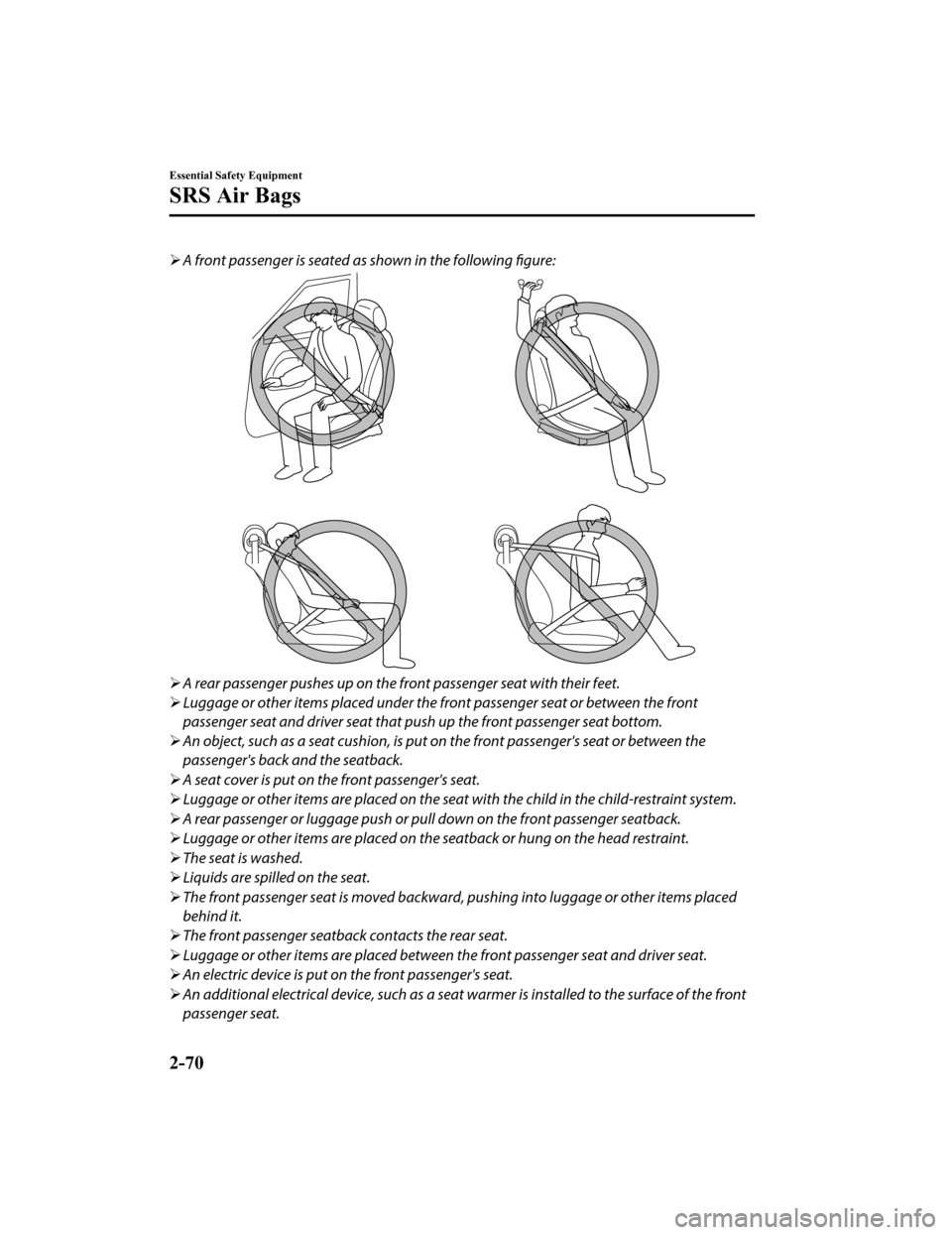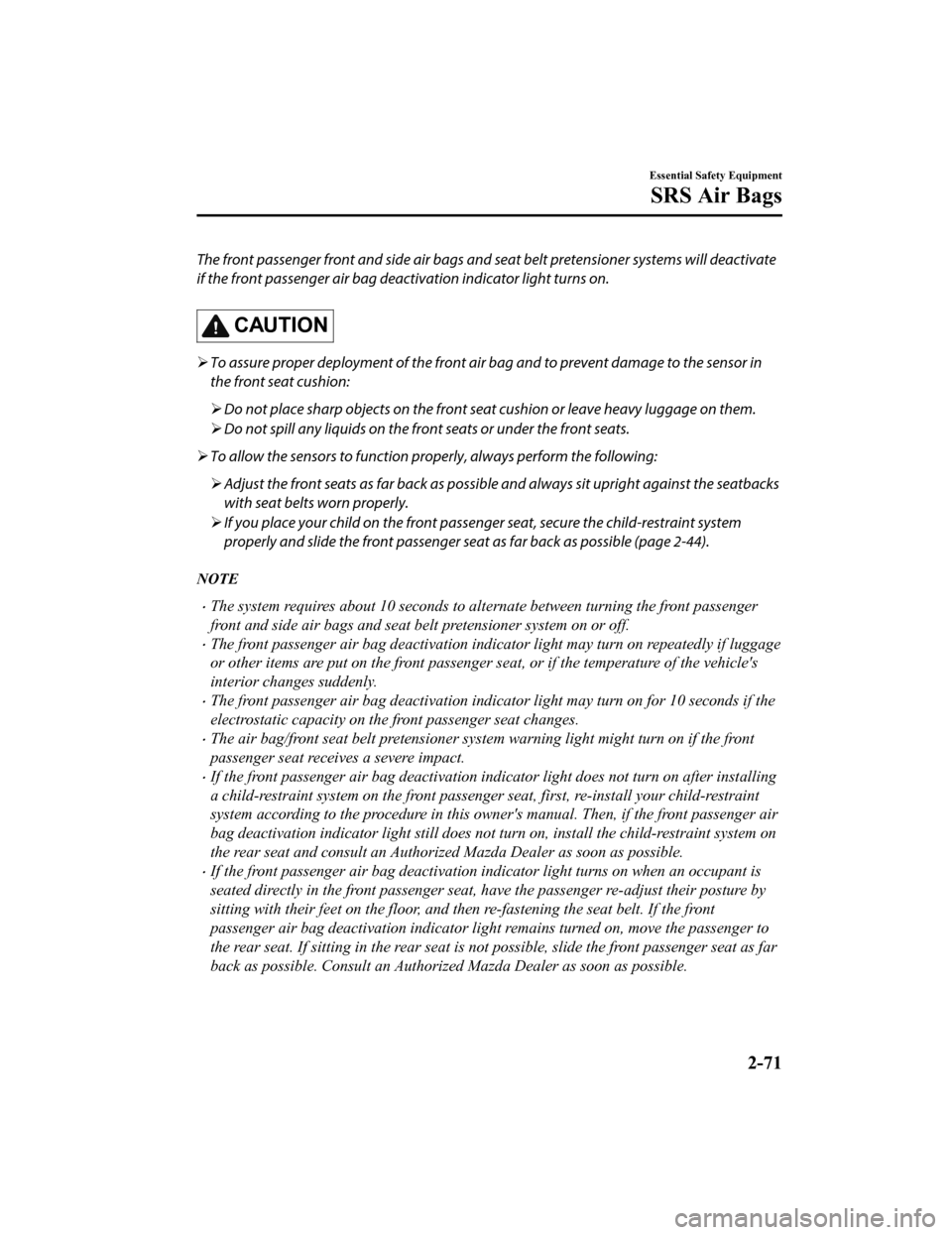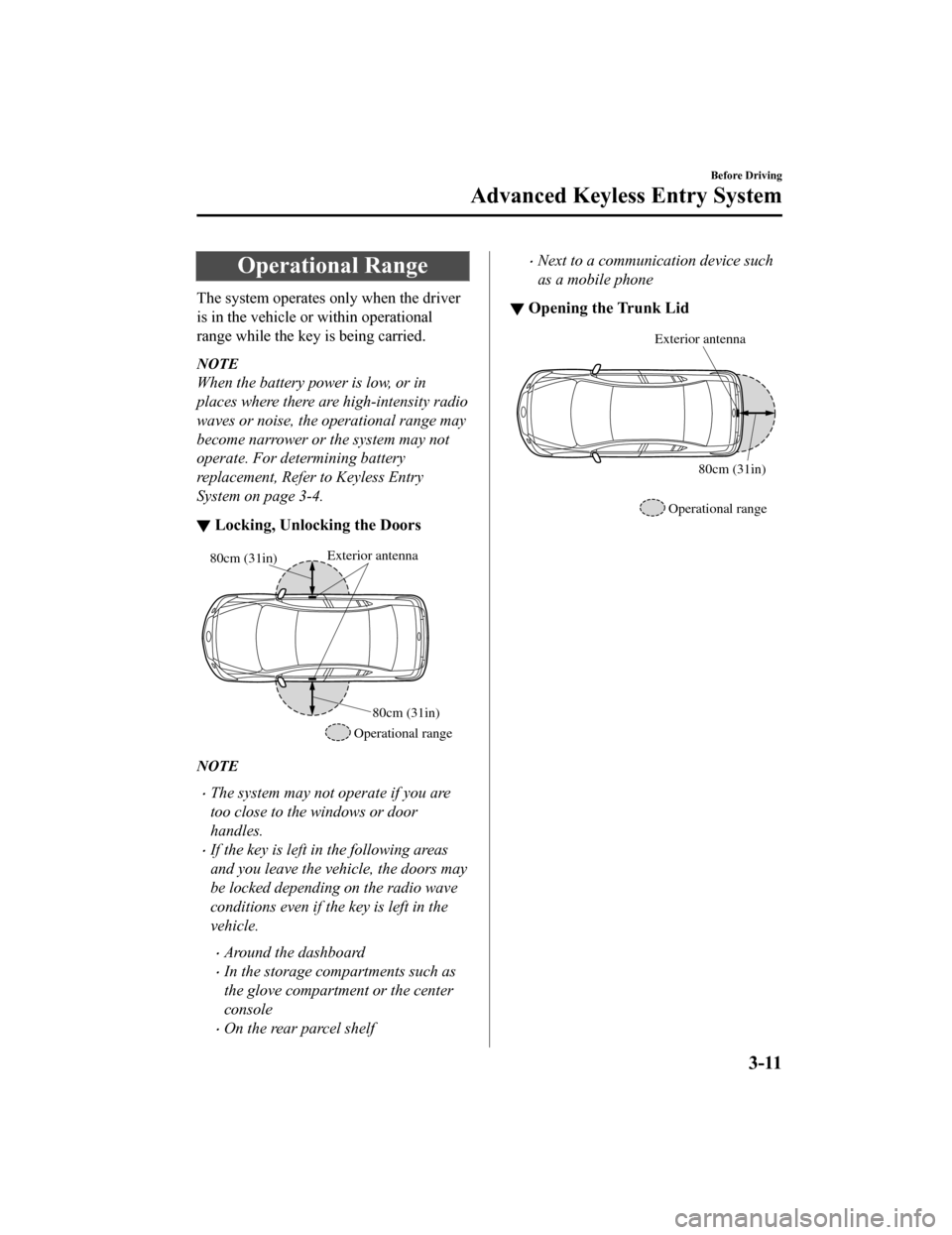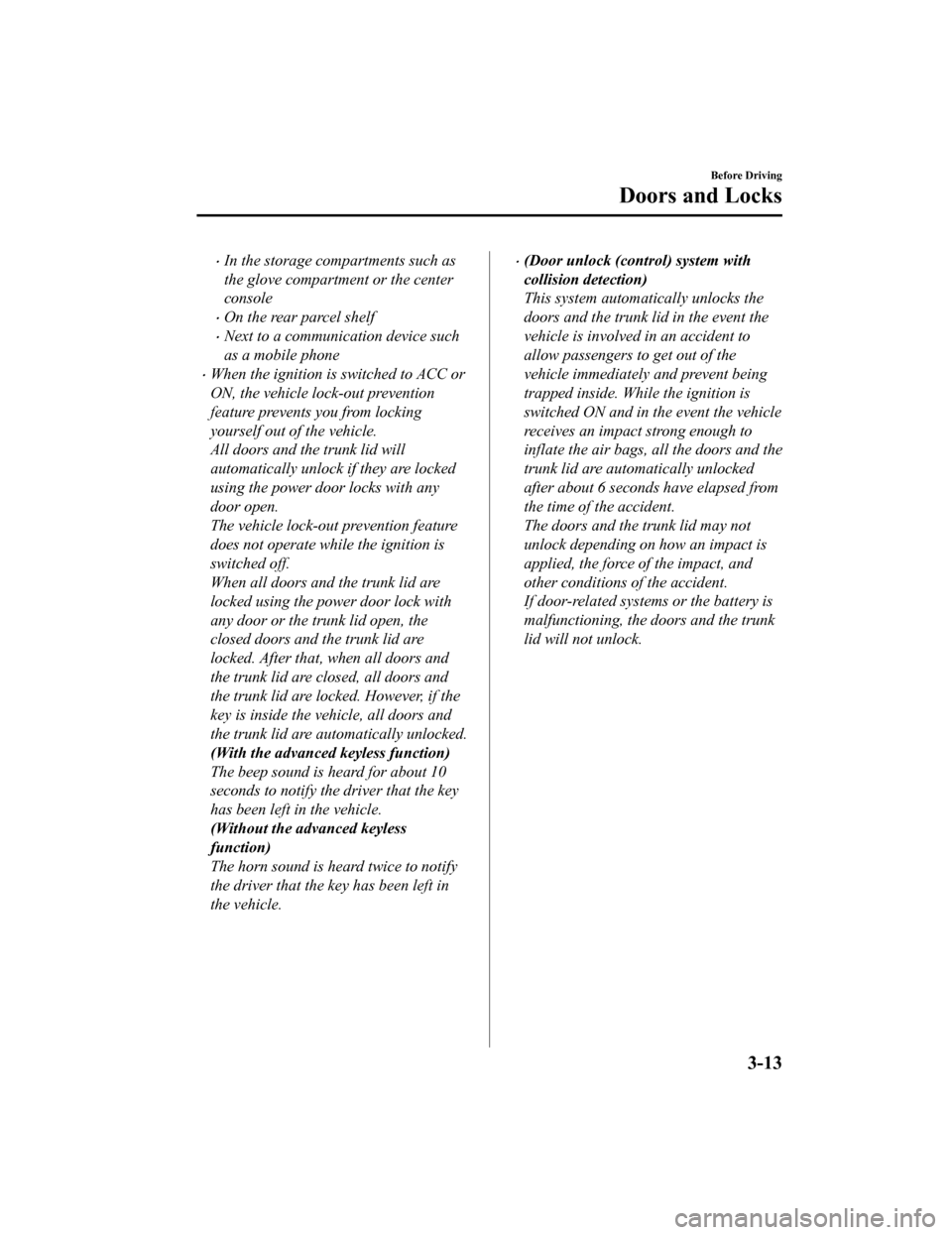rear MAZDA MODEL 6 2020 (in English) Service Manual
[x] Cancel search | Manufacturer: MAZDA, Model Year: 2020, Model line: MODEL 6, Model: MAZDA MODEL 6 2020Pages: 702
Page 72 of 702

Do not operate a vehicle with damaged air bag/seat belt pretensioner system components:
Expended or damaged air bag/seat belt pretensioner system components must be replaced
after any collision which caused them to depl oy or damage them. Only a trained Authorized
Mazda Dealer can fully evaluate these systems to see that they will work in any subsequent
accident. Driving with an expended or damage d air bag or pretensioner unit will not afford
you the necessary protection in the event of any subsequent accident which could result in
serious injury or death.
Do not remove interior air bag parts:
Removing any components such as the front se ats, front dashboard, the steering wheel or
parts on the front and rear window pillars and along the roof edge, containing air bag parts
or sensors is dangerous. These parts contain essential air bag components. The air bag could
accidentally activate and cause serious injuri es. Always have an Authorized Mazda Dealer
remove these parts.
Properly dispose of the air bag system:
Improper disposal of an air bag or a vehicle with live air bags in it can be extremely
dangerous. Unless all safety procedures are foll owed, injury could result. Have an Authorized
Mazda Dealer safely dispose of the air bag sy stem or scrap an air bag equipped vehicle.
NOTE
If it becomes necessary to have the components or wiring system for the supplementary
restraint system modified to accommodate a person with certain medical conditions in
accordance with a certified physician, contact an Authorized Mazda Dealer, refer to
“Customer Assistance (U.S.A.)” (page 8-2).
When an air bag deploys, a loud inflation noise can be heard and some smoke will be
released. Neither is likely to cause injury, however, the text ure of the air bags may cause
light skin injuries on body parts not covered with clothing through friction.
Should you sell your Mazda, we urge you to tell the new owner of its air bag systems and
that familiarization with all instructions about them, from the Owner's Manual, is
important.
This highly-visible label is displayed wh ich warns against the use of a rear-facing
child-restraint system on the front passenger seat.
(Except Mexico) (Mexico)
Essential Safety Equipment
SRS Air Bags
2-58
Mazda6_8HX3-EA-19I_Edition1_old 2019-6-18 9:25:17
Page 77 of 702

▼Curtain Air Bags
The curtain air bags are mounted in the front and rear window p
illars, and the roof edge
along both sides.
When the air bag crash sensors detect a s ide impact of greater than moderate force, the
curtain air bag inflates quickly and helps to reduce injury mainly to the rear outboard
passenger's head caused by directly hitting interior parts such as a door or window.
For more details about air bag deployment, refer to "SRS Air Ba g Deployment Criteria"
(page 2-65).
In a side impact:
Greater than moderate impact to one side of the vehicle will cause the curtain air bag on that
side only to inflate.
Only one side curtain air bag will
deploy on the side of the vehicle
that receives the force of an impact.
(With Front Passenger Occupa nt Classification System)
In a roll-over:
In response to a vehicle roll-over, both curtain air bags infla te.
Both curtain air bags will
deploy after the roll-over
accident is detected.
Essential Safety Equipment
SRS Air Bags
2-63
Mazda6_8HX3-EA-19I_Edition1_old 2019-6-18 9:25:17
Page 79 of 702

SRS Air Bag Deployment Criteria
This chart indicates the applicable SRS equipment that will deploy depending on the type of
collision.
(The illustrations are the representative cases of collisions.)
SRS equip‐ ment Types of collision
A severe frontal/near frontal colli‐ sion A severe side colli‐
sion A roll-over/near
roll-over
*2A rear collision
Front seat
belt preten‐ sioner X*1 (both sides) X*1 (both sides) X*1 (both sides)
No air bag and
front seat belt pre‐
tensioner will be
activated in a rear
collision.
Driver air
bag X
Front pas‐ senger air bag X
*1
Side air bag
X*1 (impact side
only)
Curtain air bag X (impact side on‐
ly) X (both sides)
X: The SRS air bag equipment is d
esigned to deploy in a collision.*1(With Front Passenger Occupa nt Classification System)
The front passenger front and side air bags and the seat belt pretensioner are designed to deploy when the front
passenger occupant classificati on sensor detects a passenger si tting on the front passenger's seat.
*2(With Front Passenger Occupa nt Classification System)
In a roll-over accident, the seat belt pretensioners and the cu rtain air bags deploy.
NOTE
In a frontal offset collision, the equipped air bags and pretensioners may all deploy
depending on the direction, angle, and rate of impact.
Essential Safety Equipment
SRS Air Bags
2-65
Mazda6_8HX3-EA-19I_Edition1_old 2019-6-18 9:25:17
Page 80 of 702

Limitations to SRS Air Bag
In severe collisions such as those described previously in "SRS Air Bag Deployment
Criteria", the applicable SRS air bag equipment will deploy. Ho wever, in some accidents,
the equipment may not deploy depending on the type of collision and its severity.
Limitations to front/near front collision detection:
The following illustrations are e xamples of front/near front collisions that may not be
detected as severe enough to deploy the SRS air bag equipment.
Impacts involving trees or poles Frontal offset impact to the vehicle
Rear-ending or running under a truck's tail gate
Essential Safety Equipment
SRS Air Bags
2-66
Mazda6_8HX3-EA-19I_Edition1_old
2019-6-18 9:25:17
Page 84 of 702

A front passenger is seated as shown in the following
figure:
A rear passenger pushes up on the front passenger seat with their feet.
Luggage or other items placed under the front passenger seat or between the front
passenger seat and driver seat that push up the front passenger seat bottom.
An object, such as a seat cushion, is put on the front passenger's seat or between the
passenger's back and the seatback.
A seat cover is put on the front passenger's seat.
Luggage or other items are placed on the seat with the child in the child-restraint system.
A rear passenger or luggag e push or pull down on the front passenger seatback.
Luggage or other items are placed on the seatback or hung on the head restraint.
The seat is washed.
Liquids are spilled on the seat.
The front passenger seat is moved backward, pushing into luggage or other items placed
behind it.
The front passenger seatback contacts the rear seat.
Luggage or other items are placed between the front passenger seat and driver seat.
An electric device is put on the front passenger's seat.
An additional electrical device, such as a seat warmer is installed to the surface of the front
passenger seat.
Essential Safety Equipment
SRS Air Bags
2-70
Mazda6_8HX3-EA-19I_Edition1_old 2019-6-18 9:25:17
Page 85 of 702

The front passenger front and side air bags and seat belt pretensioner systems will deactivate
if the front passenger air bag deactivation indicator light turns on.
CAUTION
To assure proper deployment of the front air bag and to prevent damage to the sensor in
the front seat cushion:
Do not place sharp objects on the front seat cushion or leave heavy luggage on them.
Do not spill any liquids on the fr ont seats or under the front seats.
To allow the sensors to function pr operly, always perform the following:
Adjust the front seats as far back as possibl e and always sit upright against the seatbacks
with seat belts worn properly.
If you place your child on the front passe nger seat, secure the child-restraint system
properly and slide the front passenger seat as far back as possible (page 2-44).
NOTE
The system requires about 10 seconds to alternate between turning the front passenger
front and side air bags and seat belt pretensioner system on or off.
The front passenger air bag deactivation indicator light may turn on repeatedly if luggage
or other items are put on the front passenger se at, or if the temperature of the vehicle's
interior changes suddenly.
The front passenger air bag deactivation indicator light may turn on for 10 seconds if the
electrostatic capacity on the front passenger seat changes.
The air bag/front seat belt pr etensioner system warning light might turn on if the front
passenger seat receives a severe impact.
If the front passenger air bag deactivation indicator light does not turn on after installing
a child-restraint system on the front passenger seat, first, re-install your child-restraint
system according to the procedure in this owner's manual. Then, if the front passenger air
bag deactivation indicator light still does not turn on, install the child-restraint system on
the rear seat and consult an Authorized Mazda Dealer as soon as possible.
If the front passenger air bag deactivation indicator light turns on when an occupant is
seated directly in the front passenger seat , have the passenger re-adjust their posture by
sitting with their feet on the floor, and then re-fastening the seat belt. If the front
passenger air bag deactivation indicator light remains turned on, move the passenger to
the rear seat. If sitting in the rear seat is not possible, slide the front passenger seat as far
back as possible. Consult an Authorized Mazda Dealer as soon as possible.
Essential Safety Equipment
SRS Air Bags
2-71
Mazda6_8HX3-EA-19I_Edition1_old 2019-6-18 9:25:17
Page 94 of 702

3. Press any of the buttons on thetransmitter to mak e sure that the
operation indicator light does not turn
on/flash.
Turning off the power saving function
After you have turned off the power
saving function according to the following
procedure, the hazard warning lights and
sound operate
*1 one time.
1. Press any of the buttons on the
transmitter to mak e sure that the
operation indicator light does not turn
on/flash.
2. Press the lock butt on on the transmitter
4 times within 3 seconds to turn on the
operation indicator light.
3. Press the lock button continuously for 1.5 seconds or longer while the
operation indicator light turns on (for 5
seconds).
*1 With the advanced keyless function
▼Operational Range
The system operates only when the driver
is in the vehicle or within operational
range while the key is being carried.
Starting the Engine
NOTE
Starting the engine may be possible even
if the key is outside of the vehicle and
extremely close to a door and window,
however, always start the engine from
the driver's seat.
If the vehicle is started and the key is not
in the vehicle, the vehicle will not restart
after it is shut off and the ignition is
switched to off.
The trunk is out of the assured
operational range, however, if the key
(transmitter) is operable the engine will
start.
With the advanced keyless function
Interior antenna
Operational range
Without the advanced keyless function
Interior antennaOperational range
NOTE
The engine may not start if the key is
placed in the following areas:
Around the dashboard
In the storage compar tments such as the
glove compartment or the center console
On the rear parcel shelf
Before Driving
Keys
3-8
Mazda6_8HX3-EA-19I_Edition1_old 2019-6-18 9:25:17
Page 97 of 702

Operational Range
The system operates only when the driver
is in the vehicle or within operational
range while the key is being carried.
NOTE
When the battery power is low, or in
places where there are high-intensity radio
waves or noise, the operational range may
become narrower or the system may not
operate. For determining battery
replacement, Refer to Keyless Entry
System on page 3-4.
▼ Locking, Unlocking the Doors
Exterior antenna
Operational range80cm (31in)
80cm (31in)
NOTE
The system may not operate if you are
too close to the windows or door
handles.
If the key is left in the following areas
and you leave the vehicle, the doors may
be locked depending on the radio wave
conditions even if the key is left in the
vehicle.
Around the dashboard
In the storage compartments such as
the glove compartment or the center
console
On the rear parcel shelf
Next to a communication device such
as a mobile phone
▼
Opening the Trunk Lid
Exterior antenna
Operational range 80cm (31in)
Before Driving
Advanced Keyless Entry System
3-11
Mazda6_8HX3-EA-19I_Edition1_old
2019-6-18 9:25:17
Page 99 of 702

In the storage compartments such as
the glove compartment or the center
console
On the rear parcel shelf
Next to a communication device such
as a mobile phone
When the ignition is switched to ACC or
ON, the vehicle lock-out prevention
feature prevents you from locking
yourself out of the vehicle.
All doors and the trunk lid will
automatically unlock if they are locked
using the power door locks with any
door open.
The vehicle lock-out prevention feature
does not operate while the ignition is
switched off.
When all doors and the trunk lid are
locked using the power door lock with
any door or the trunk lid open, the
closed doors and the trunk lid are
locked. After that, when all doors and
the trunk lid are closed, all doors and
the trunk lid are locked. However, if the
key is inside the vehicle, all doors and
the trunk lid are auto matically unlocked.
(With the advanced keyless function)
The beep sound is heard for about 10
seconds to notify the driver that the key
has been left in the vehicle.
(Without the advanced keyless
function)
The horn sound is heard twice to notify
the driver that the key has been left in
the vehicle.
(Door unlock (control) system with
collision detection)
This system automatically unlocks the
doors and the trunk lid in the event the
vehicle is involved in an accident to
allow passengers to get out of the
vehicle immediatel y and prevent being
trapped inside. While the ignition is
switched ON and in the event the vehicle
receives an impact strong enough to
inflate the air bags, all the doors and the
trunk lid are automatically unlocked
after about 6 seconds have elapsed from
the time of the accident.
The doors and the trunk lid may not
unlock depending on how an impact is
applied, the force of the impact, and
other conditions of the accident.
If door-related systems or the battery is
malfunctioning, the doors and the trunk
lid will not unlock.
Before Driving
Doors and Locks
3-13
Mazda6_8HX3-EA-19I_Edition1_old 2019-6-18 9:25:17
Page 103 of 702

This does not operate the other door locks.
Lock
Unlock
Unlocked: Red indicator
Operation from outside
To lock any door using its door-lock knob
from the outside, press the door-lock knob
to the lock position and close the door
(holding the door handle in the open
position is not required).
This does not operate
the other door locks.
Door-lock knob
NOTE
When locking the door this way:
Be careful not to lea ve the key inside the
vehicle.
The doors cannot be locked using the
driver's door lock knob if any door is
open when the ignition is switched to
ACC or ON.
▼ Rear Door Child Safety Locks
These locks are intended to help prevent
children from accidentally opening the
rear doors. Use them on both rear doors
whenever a child rides in the rear seat of
the vehicle.
If you slide the chil
d safety lock to the
lock position before closing that door, the
door cannot be opened from the inside.
The door can only be opened by pulling
the outside handle.
Lock Unlock
Before Driving
Doors and Locks
3-17
Mazda6_8HX3-EA-19I_Edition1_old
2019-6-18 9:25:17